Advertisements
Advertisements
Question
In each of the figures given below, an altitude is drawn to the hypotenuse by a right-angled triangle. The length of different line-segment are marked in each figure. Determine x, y, z in each case.
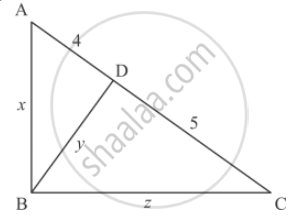
Solution
Δ ABC is right angled triangle right angled at B
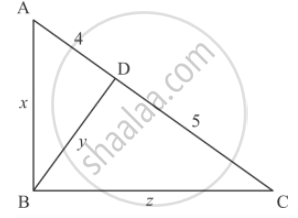
`AB^2+BC^2= AC ^2`
`x^2+z^2=(4+5)^2`
`x^2+z^2=9^2`
`x^2+z^2=81`...............(1)
Δ BAD is right triangle right angled at D
`BD^2+AD^2=AB^2`
`y^2+4^2=x^2`
`y^2+16=x^2`
`16=x^2-y^2`...............(2)
Δ BDC is right triangle right angled at D
`BD^2+DC^2=BC^2`
`y^2+25=z^2`
`25 = z^2-y^2`..................(3)
By canceling equation (1) and (3) by elimination method, we get
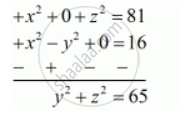
y canceling and by elimination method we get

`z^2=90/2`
`z^2=45`
`z=sqrt45`
`z=sqrt(3xx3xx5)`
`z=3sqrt5`
Now, substituting `z^2=45` in equation (iv) we get
`y^2+z^2=65`
`y^2+45=65`
`y^2=65-45`
`y^2=20`
`y = sqrt20`
`y=sqrt(2xx2xx5)`
`y=2sqrt5`
Now, substituting `y^2=20` in equation (ii) we get
`x^2-y^2=16`
`x^2-20=16`
`x^2=16+20`
`x^2=36`
`x=sqrt36`
`x=sqrt(6xx6)`
`x = 6`
Hence the values of x, y, z is `6,2sqrt5,3sqrt5`
APPEARS IN
RELATED QUESTIONS
D and E are points on the sides AB and AC respectively of a ΔABC. In each of the following cases, determine whether DE║BC or not.
AD = 7.2cm, AE = 6.4cm, AB = 12cm and AC = 10cm.

In a ΔABC, AD is the bisector of ∠A.
If AB = 5.6cm, AC = 4cm and DC = 3cm, find BC.

In each of the following figures, you find who triangles. Indicate whether the triangles are similar. Give reasons in support of your answer.
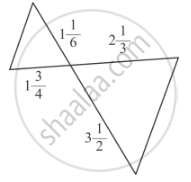
The areas of two similar triangles are 169 cm2 and 121 cm2 respectively. If the longest side of the larger triangle is 26 cm, what is the length of the longest side of the smaller triangle?
In the given figure, LM = LN = 46°. Express x in terms of a, b and c where a, b, c are lengths of LM, MN and NK respectively.

The areas of two similar triangles are 121 cm2 and 64 cm2 respectively. If the median of the first triangle is 12.1 cm, then the corresponding median of the other triangle is
In the given figure, the value of x for which DE || AB is
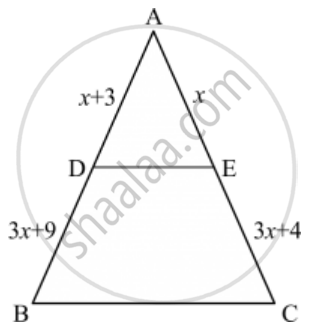
In the given figure, if PB || CF and DP || EF, then \[\frac{AD}{DE} =\]
In ∆ABC, a line XY parallel to BC cuts AB at X and AC at Y. If BY bisects ∠XYC, then
In an isosceles triangle ABC if AC = BC and AB2 = 2AC2, then ∠C =
